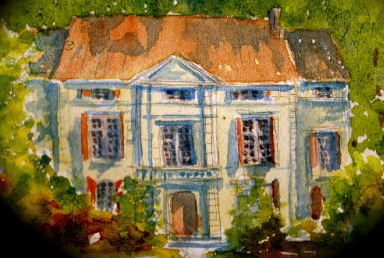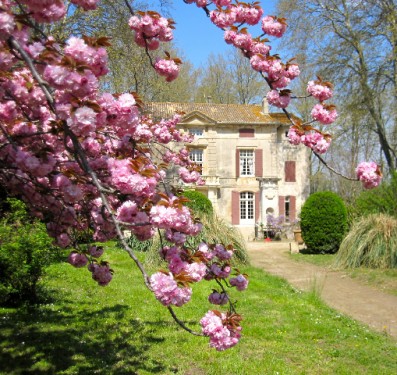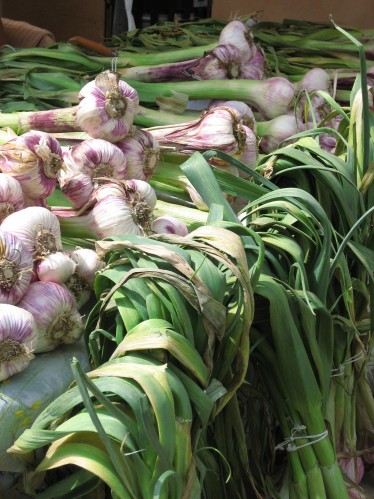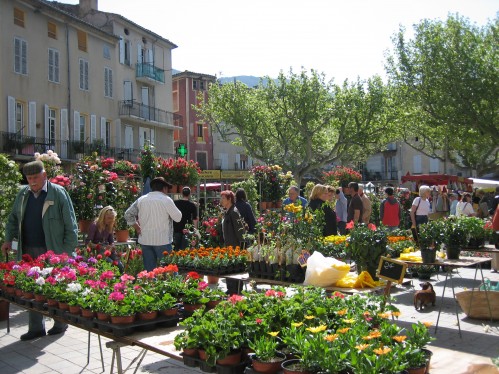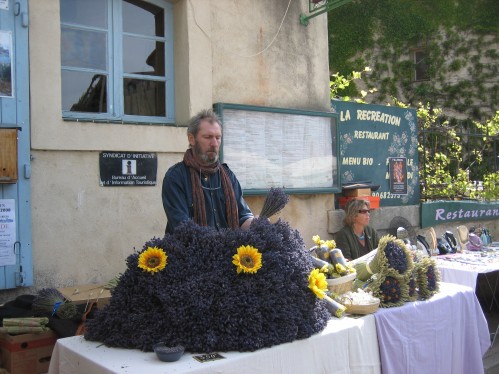 Special guest writer, Julie Mautner, gives us an insider's view on lavender in Provence. If you have never seen fields of Provence lavender bursting in bloom, a trip to Provence could be in your future.
Special guest writer, Julie Mautner, gives us an insider's view on lavender in Provence. If you have never seen fields of Provence lavender bursting in bloom, a trip to Provence could be in your future.
Food and travel writer Julie Mautner has lived in St. Remy de Provence on and off for more than ten years. Prior to running off to the South of France, she was the executive editor of Food Arts Magazine in New York for ten years. Today she freelances for food and travel magazines, and sites in the US and UK. Julie's popular blog, The Provence Post is a written pulse on Provence. Her first book, The Food Network South Beach Wine & Food Festival Cookbook, will be published by Clarkson Potter in November 2010...VintageGardenGal
Driving or biking through Provence in mid-summer, you’ll see lavender fields of every size and hue. The main growing area is the triangle between Sault, Banon and Sederon, and another prominent area spreads out on the other side of Mont Ventoux, north of Nyons. But pretty much all of Provence is radiant with the famous Blue Gold, as lavender is known, throughout the month of July.
The first lavender distilleries began production in the 1880s, and by 1929 there were 47 stills around the town of Sault alone. Today, the tiny town of Sault is still considered the lavender capital of Provence and its three distilleries are open to the public. The Sault Tourist Office offers seven guided tours of the principal lavandicoles or growing sites. In the town of Coustellet, you'll find a small museum devoted to lavender production, complete with a collection of copper stills dating from the 16th century.
If you time your trip right, you may catch a village lavender festival, like the ones in Sault and Valreas, or the biggie, the four-day Corso de la Lavande, in the mountain spa town of Digne-les-Baines. Held the first weekend in August, the festival offers lavender for sale in every form imaginable, edible and otherwise, and a parade of large flower-decked floats. A municipal truck leads the parade, spraying the roads with lavender water and leaving the entire town awash in the distinctive summery scent.
Don’t feel like going it alone? A lavender-themed tour is a great way to get the experience. This year, for example, an Australian company called Aroma Tours has organized five different Provencal trips including a Lavender Tour to be held July 23rd to 30th. Provence Reservation and City Discovery both offer one-day lavender tours from Avignon while others book similar half and full day tours out of Aix-en-Provence. Whichever tour operator you choose, rest assured you’ll be knee deep in lavender before well before lunch.
Around Provence you'll find scores of edible lavender goodies being made and sold, in shops, open-air markets and even larger grocery stores. In St. Remy, the cookie and sweet shop called Au Petit Duc sells little tins of crystallized lavender seeds, to be nibbled after garlicky meals, and biscuits à la lavande. Next door to Petit Duc, patissier Joel Durand sells homemade chocolates flavored with lavender, rosemary and other botanicals.
Lavender tea is a soothing drink thought by many to have medicinal qualities. But if you want something with more kick, you can get that from lavender too. And for that you don’t even need a passport.
Lisa Averbuch says her favorite flavor of all time is—wait for it—lavender. So it makes sense that her company, Loft Organic Liqueurs in Emeryville, California, turns out a killer lavender liqueur called Lavender Cello. (The whole company was inspired, she says, by the famous lemony Italian digestif. They also produce liqueurs made from lemongrass, ginger, raspberry, blueberry and tangerine.) Available year round, the lavender liqueur has all the floral aromas and smooth flavors you’ld expect, without any additives, preservatives, artificial flavors “or other items you would find in a Twinkie,” Averbuch says.
If you’re heading for France and plan to hit the lavender trail, there are many resources that can help.
The French Tourism Development Agency, also known as Atout France, offers an online guide for lavender lovers. To download it, click here France Guide Brochures, and scroll down to the publication called “Rhone Alpes: Lavender Routes 2009.”
The Association Grande Traversée des Alpes, (http://www.grande-traversee-alpes.com/my-journey/by-road/the-lavender-trail.html) also offers useful info about lavender and “La Route de la Lavande.” On the site you’ll find suggestions for the best drives and hikes, plus distillieries, lavender-themed activities, hiking, workshops and more.
And you’ll find more great lavender info on these two sites:
http://www.avignon-et-provence.com/provence-tourism/lavender/farm-lavender.htm
http://www.beyond.fr/themes/lavender_th.html
Sources and Resources Hint: To call from the U.S., precede all phone numbers with 011-33, and drop the first 0.
*Tourist Office, Sault. http://www.saultenprovence.com/gb/, 04-90-64-01-21
*Tourist Office, Valreas. http://www.ot-valreas.fr/uk/index.php5, 04-90-35-04-71
*Tourist Office, Digne-les-Bains. http://www.ot-dignelesbains.fr/www-accueil-138-UK-DIGNE_LES_BAINS.html, 04-92-31-50-02
*Musee de la Lavande. Route de Gordes, Cabrieres d'Avignon, 84220 Coustellet. 04-90-76-91-23. Fax 04-90-76-85-52. http://www.thelavendermuseum.com/
*Au Petit Duc, St. Remy, 04-90-92-08-31, www.petit-duc.com
*Joel Durand Chocolatier, 04-90-92-38-25, www.chocolat-durand.com
*Lavender Cello is made by Loft Liqueurs,Emeryville, California, www.loftliquors.com,theLOFT@LOFTliqueurs.com
*Lavender Tours are available from many companies including:
City Discovery (www.city-discovery.com/provence/)
Provence Reservation (http://www.provence-reservation.com/en_2/index.php)
Aroma Tours (www.aroma-tours.com)
If You Love Lavender...concludes our "Encore Provence Series" with special guest writers Julie Mautner and James Clay. Many thanks for their delightful writing and armchair travel to charming Provence. Please share your comments.

